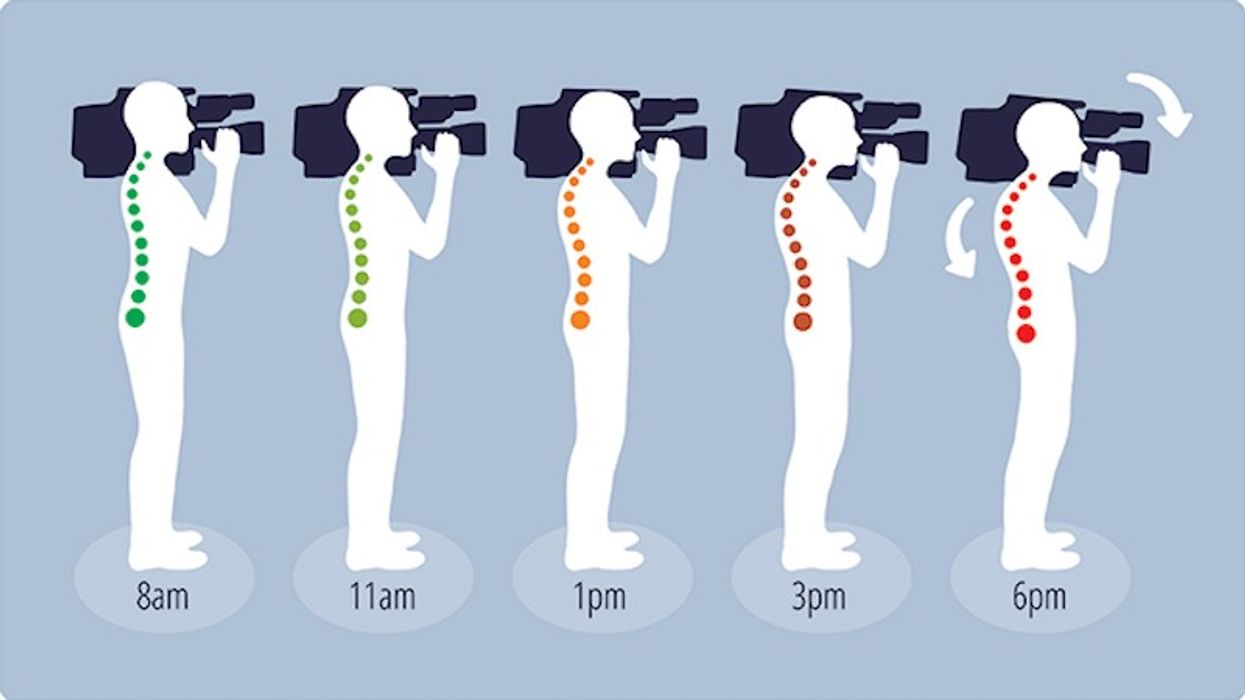What Are the Risk Factors of Being a Professional Camera Operator?
Camera ergonomics are no joke—just ask all of the veteran camera operators with back problems.

If you lug around a camera all day, maybe you work in journalism or documentaries, you know that all of that standing and carrying has a serious impact on your posture, body, and overall health. South Korea's Department of Occupational and Environmental Medicine conducted a study last year on the risk factors of "work-related upper extremity musculoskeletal disorders", or WRMSDs, in male cameramen and their findings are pretty interesting.
The team asked 166 broadcast cameramen questions regarding their work schedules, including average work/break duration, health habits, physical burden, and "musculoskeletal symptoms, which include localized/widespread pain, aching or stiffness, fatigue, sleep disturbances, and more. Here's a bit from the introduction, which gives a little bit of insight into the perspective of the study:
Cameramen are usually divided into two groups. The first group works with a portable camera that weighs about 10Kg or heavier. As all types of the portable camera are right-handed, they cannot change the shoulders during working. In the face of these facts their musculoskeletal disorders are mostly influenced by the weight and contact stress. The other form of work is to control a studio camera that is fixed on the ground. They do not get any weight or contact stress from their work. Instead of that, they have to keep their posture all the time during working hours. In both type of work, they usually raise their arm and shoulder for a long time. Comparatively, their lower extremities are ergonomically stable. And they can stretch or change their lower extremities position while they are working. In consideration of their working posture and contact stress from the heavy camera, upper extremities will get a more harmful influence than lower extremities. Thus, we only focused on the upper extremities in this study.
They learned that 14.5% of all participants reported symptoms in their shoulders, which was the highest recorded (the lowest, at 6%, being in the arms). This obviously makes sense since these types of camera operators carry heavy cameras on their shoulders for long hours with few breaks. However according to the study, there are more risk factors that play a role in increased reports of shoulder symptoms other than how many hours one works, including BMI, physical burden, and ergonomic factors. The team concluded with:
The most serious musculoskeletal disorders of male cameramen were shoulder pain. Ergonomic factors and physical burden were the most significant factors affecting WRMSDs in cameramen in this study. Cameramen should be educated to be able to improve the ergonomic occupational environment and to set up preventive measures against the risk factors during work.
Though it was created by RedShark News to promote the Sony PXW-X400, this infographic touches on a few of these statistics from the study. I mean, you can just as easily replace the camera model with "a well-balanced, lightweight, and ergonomically sound shoulder-mounted camera." But even though part of the problem stems from having to carry heavy and unwieldy cameras around all day, part of it is non-occupational. This means that there might be some things you could do at home, like exercising regularly, that may help you lesson some of the risks of being a camera operator.

Source: BioMed Central











![Ethos, Pathos, Logos: 20 Effective Ways to Advertise [Infographic]](https://nofilmschool.com/media-library/ethos-pathos-logos-20-effective-ways-to-advertise-infographic.jpg?id=34064614&width=600&height=600&quality=90&coordinates=560%2C0%2C0%2C0)

